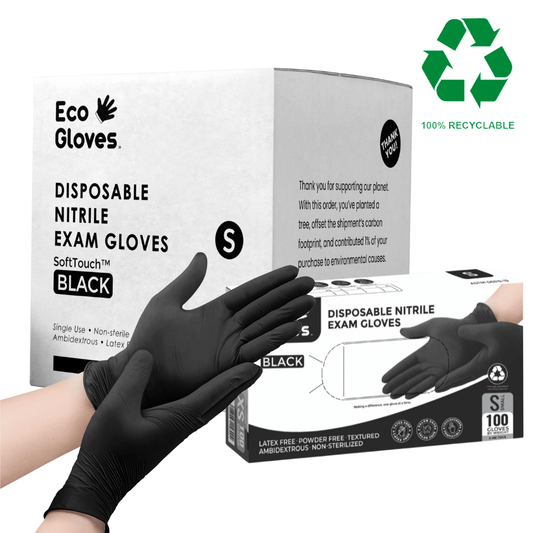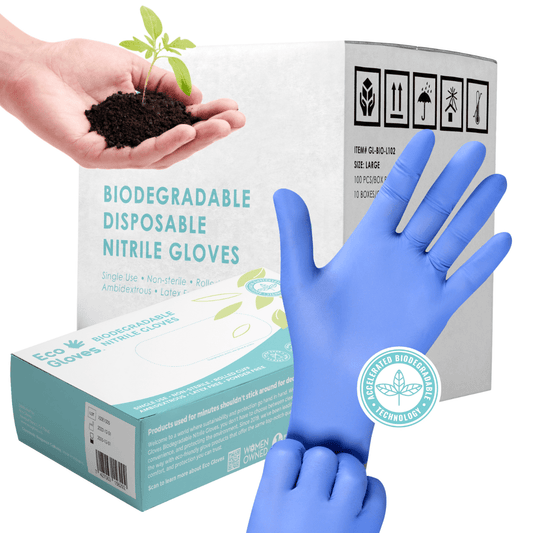Understanding the Different Levels of Cut and Puncture Resistance in Disposable Gloves
Eco Gloves

In industries where safety is paramount, selecting suitable disposable gloves can make all the difference. Disposable gloves are essential for protecting hands from hazards such as cuts and punctures, but not all gloves are created equal and offer the same level of protection. Understanding the various cut and puncture resistance levels is crucial for choosing the appropriate gloves for your needs.
This guide will dive into the different types of gloves that provide cut and puncture resistance, the standards that measure these properties, and how to make an informed decision when selecting disposable gloves.
Topics Covered
- Types Of Gloves That Provide Cut And Puncture Resistance
- Understanding Cut And Puncture Resistance Standards
- How Glove Thickness Affects Resistance Levels
- Choosing The Right Glove For Your Needs
- Practical Examples Of Glove Selection
- The Environmental Impact of Disposable Gloves
- Protect Your Hands And The Planet With Eco Gloves
- Key Takeaways: Choosing Cut & Puncture-Resistant Disposable Gloves
- Frequently Asked Questions About Cut & Puncture Resistance in Disposable Gloves
Types Of Gloves That Provide Cut And Puncture Resistance
Disposable gloves come in various materials, each offering different cut and puncture resistance levels. The most common types are:
Nitrile Gloves
Nitrile gloves are known for their superior puncture resistance compared to latex or vinyl gloves. They are widely used in medical, laboratory, and industrial settings where protection against sharp objects is needed. Additionally, it offers excellent chemical resistance, making it versatile for industries like manufacturing, foodservice, and cleaning.
Latex Gloves
Latex gloves provide flexibility and dexterity but are not as resistant to punctures as nitrile. While still protective, latex is better suited for lower-risk tasks or where comfort and elasticity are a priority.
Vinyl Gloves
Vinyl gloves are less expensive but also offer lower protection against cuts and punctures. They are often used in food service or low-risk environments where the primary concern is hygiene rather than high levels of security.
Understanding Cut And Puncture Resistance Standards
When selecting disposable gloves, it’s essential to understand the standards that measure cut and puncture resistance. The two primary standards are ANSI/ISEA and EN 388.
ANSI/ISEA 105 Standard
The American National Standards Institute provides a rating system for cut and puncture resistance, with levels indicating the glove's protective ability. The ANSI/ISEA 105 standard classifies gloves in North America based on their cut resistance. The standard rates gloves on a scale from A1 to A9, with A1 providing the least protection and A9 offering the highest level of cut resistance. For puncture resistance, the gloves are rated from 1 to 5, with five being the most resistant.
EN 388 Standard
The EN 388 standard is a European standard that measures several protective properties, including abrasion, cut, tear, and puncture resistance. The cut resistance is rated on a scale of 1 to 5, while puncture resistance is rated from 1 to 5. In addition, EN 388 includes a test for impact resistance, which may be relevant in some industries.
How Glove Thickness Affects Resistance Levels
Glove thickness is a crucial factor in determining protection against cuts, punctures, and general wear, but it also influences dexterity and comfort. Disposable glove thickness is typically measured in mils, where 1 mil equals 0.001 inches. Gloves usually range from 2 to 8 mils thick, with different thicknesses suited for specific tasks:
- 2-3 mils: Thin gloves in this range offer enhanced tactile sensitivity and are ideal for tasks requiring fine motor skills, such as medical exams, food handling, or precision work in beauty and salon settings. However, these gloves offer less protection against punctures and cuts and are better suited for low-risk environments.
- 4-5 mils: Mid-range thickness gloves strike a balance between protection and dexterity. Gloves like these are suitable for tasks where puncture resistance is important, such as handling tools, chemicals, or light industrial work. They offer more durability than thinner gloves without compromising flexibility.
- 6-8 mils: These thicker gloves are designed for high-risk environments requiring significant protection from cuts, punctures, or harsh chemicals. Commonly used in industrial, automotive, and heavy-duty cleaning tasks, these gloves provide excellent durability but may limit hand flexibility and tactile sensitivity.
As glove thickness increases, you can expect greater protection, but reduced dexterity. It's essential to choose the right balance based on your task's demands to ensure both safety and efficiency.
Choosing The Right Glove For Your Needs
Selecting the ideal disposable glove requires a comprehensive understanding of the specific hazards within your work environment. By assessing these factors, you can make an informed choice that not only enhances protection but also ensures comfort and functionality. Here’s a breakdown of how to choose the right glove:
Assess the Hazards
Begin by identifying the primary risks you’re exposed to. Different environments pose unique challenges:
- Cut Hazards: If you're working with sharp tools, glass, or metal edges, a higher cut resistance level is crucial.
- Puncture Hazards: For tasks involving needles, wires, or rough surfaces, puncture resistance is a key factor.
- Dual Protection: Some tasks may require both cut and puncture resistance, necessitating gloves that excel in both categories. Understanding the type and severity of the hazard helps you match glove performance to your specific needs.
Match the Material to the Task
When selecting disposable gloves, the material plays a critical role in determining the level of protection they provide. Different tasks and environments call for specific glove materials to ensure safety and performance. Nitrile, latex, and vinyl each offer unique advantages depending on the hazards present, such as exposure to sharp objects, chemicals, or the need for dexterity. Understanding the strengths and limitations of each material is key to choosing the right glove for the job.
Consider Dexterity and Comfort
Opt for gloves that balance protection and dexterity if your tasks require precision. Thinner nitrile Your glove should provide adequate protection without compromising dexterity, especially for tasks that require precision:
- Thickness vs. Flexibility: Thicker gloves typically offer greater protection but may reduce hand mobility. Opt for gloves like thinner nitrile if you need protection without sacrificing flexibility.
- Fit and Comfort: A well-fitted glove is essential for minimizing fatigue and ensuring ease of movement during prolonged use. Consider gloves with ergonomic designs that mold to the natural shape of your hand for comfort and dexterity.
Check the Standards
Ensure the gloves you choose meet the relevant cut and puncture resistance standards, such as ANSI/ISEA 105 or EN 388. Choosing gloves that meet or exceed these ratings ensures compliance and optimal safety for your industry’s needs.
Factor in Additional Needs
Chemical Exposure: If working in environments involving chemicals, ensure the gloves provide adequate chemical resistance in addition to cut and puncture protection.
Industry-Specific Requirements: Healthcare, foodservice, and manufacturing industries often have specific glove regulations. Check for certifications or approvals that meet your industry's standards.
Practical Examples Of Glove Selection
In healthcare, where needle punctures are ordinary, nitrile gloves with high puncture resistance (ANSI/ISEA Level 3 or higher) are recommended. In contrast, food service workers may prioritize comfort and hygiene, opting for vinyl gloves where puncture and cut risks are minimal.
In industrial settings, such as construction or manufacturing, gloves with a high cut resistance rating (ANSI/ISEA A4 or higher) may be necessary, particularly when handling sharp tools or materials. A thicker nitrile glove may offer the best balance between protection and usability.
The Environmental Impact of Disposable Gloves
While disposable gloves are crucial for safety, they can also have an environmental impact. Traditional disposable gloves are often made from non-biodegradable materials, contributing to plastic waste.
Eco-Friendly Alternatives
For those looking to minimize their environmental footprint, eco-friendly options like Eco Gloves Biodegradable Nitrile Gloves provide a sustainable alternative without compromising protection. Additionally, Eco Gloves offers 4 mil, 5 mil, 6 mil and 8 mil thick standard nitrile gloves that offer nitrile options that meet high cut and puncture resistance standards while being recyclable. Being more environmentally responsible.
Protect Your Hands And The Planet With Eco Gloves
Understanding the different levels of cut and puncture resistance in disposable gloves is essential for selecting the proper protection for your work environment. Choosing the right glove can make all the difference in healthcare, construction, or manufacturing.
Explore Eco Gloves for superior protection that doesn’t compromise sustainability. Our puncture-resistant gloves meet industry standards while supporting eco-friendly practices. Protect your hands and the planet with Eco Gloves. Visit our website today to find the perfect solution for your needs.
ey Takeaways: Choosing Cut & Puncture-Resistant Disposable Gloves
-
Know the Difference: Cut resistance protects against slicing hazards; puncture resistance protects against pointed objects like needles or nails.
-
Check the Standards: Look for ANSI/ISEA 105 or EN 388 ratings to verify a glove’s protection level.
-
Match Material to Risk: Nitrile offers the highest puncture resistance; latex is flexible but less puncture-resistant; vinyl is best for low-risk tasks.
-
Thickness Matters: Higher mil thickness increases durability but may reduce dexterity—choose the right balance for your work.
-
Industry-Specific Needs: Healthcare, construction, and manufacturing often require higher protection levels than foodservice or salon work.
-
Eco-Friendly Options Available: Biodegradable and recyclable nitrile gloves from Eco Gloves provide safety without compromising sustainability.
👉 Selecting the right gloves ensures safety, comfort, and compliance—while also allowing you to make environmentally responsible choices.
Frequently Asked Questions About Cut & Puncture Resistance in Disposable Gloves
-
What’s the difference between cut and puncture resistance?
Cut resistance protects against slicing from sharp objects, while puncture resistance prevents penetration from pointed items like needles or nails.
-
How can I tell if a glove is cut and puncture-resistant?
Check for ratings under ANSI/ISEA 105 or EN 388 standards—these indicate tested levels of protection.
-
Can I reuse disposable gloves if they seem undamaged?
No. Disposable gloves are designed for single use, and reusing them can compromise their protective qualities.
-
Are thicker gloves always better for protection?
Thicker gloves often provide more protection but can limit dexterity. Choose based on your task’s needs.
-
Which industries need puncture-resistant gloves the most?
Healthcare, construction, manufacturing, and waste management rely heavily on puncture-resistant gloves due to frequent contact with sharp or pointed objects.
Related Reading
- A Guide to Nitrile Glove Recycling: Sustainable Practices for Eco-Conscious Businesses
- Sustainable Solutions for Disposable Glove Use in Manufacturing and Packaging Industries
- The Science of Sustainability: Comparative Analysis of Biodegradable vs. Traditional Gloves

















